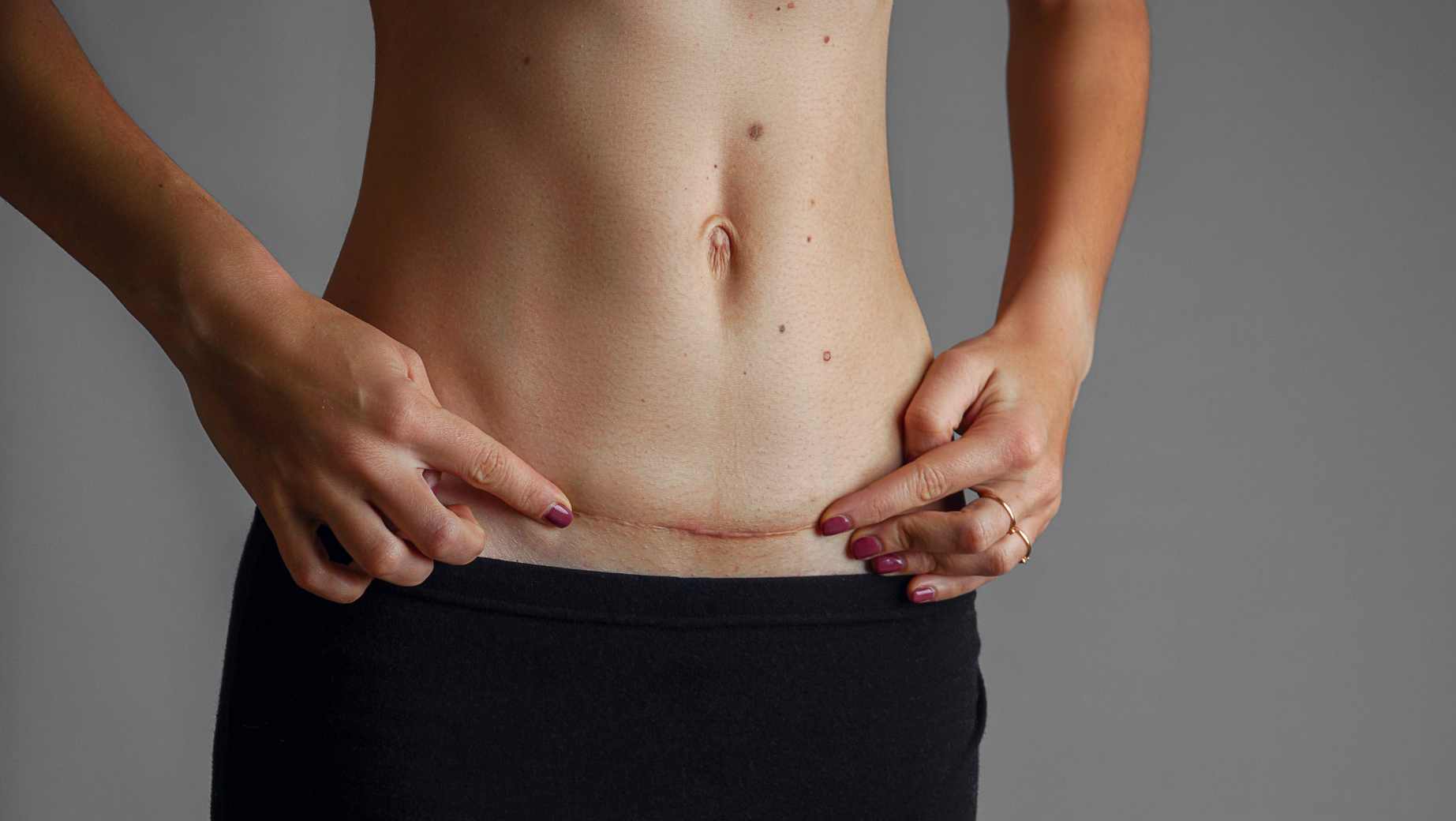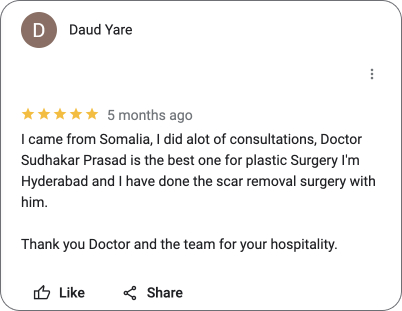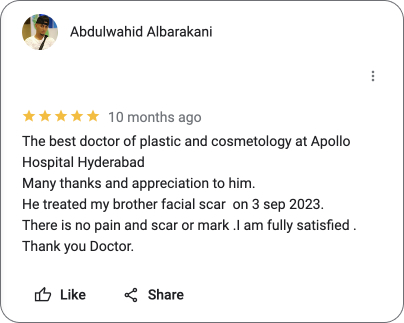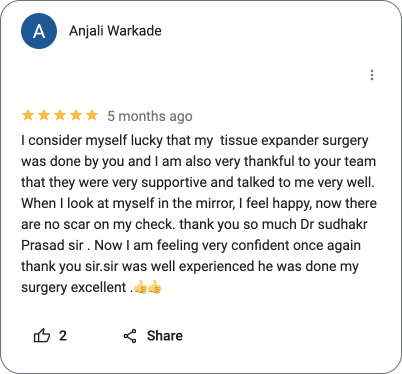
Many people considering cosmetic or reconstructive surgery worry about scars. While scarring is a natural part of the healing process, minimizing its appearance and optimizing scar health are crucial for a positive outcome. Dr. Sudhakar Prasad, a renowned plastic surgeon in Hyderabad with over 28 years of experience, understands these concerns. Dr. Prasad is a skilled scar management expert who can help you achieve the best possible results following your surgery.
Understanding Scars and the Healing Process: Insights into Scar Formation and Recovery
Scars form as the body repairs itself after a wound or incision. Different types of scars exist, including:
- Keloids: Raised, thickened scars that grow beyond the original wound.
- Hypertrophic scars: Red, raised scars that stay within the wound boundaries.
- Atrophic scars: Depressed scars that form below the skin’s surface.
Dr. Prasad will assess your risk factors for scar formation during your consultation. Early intervention is key, so starting scar management strategies right after surgery is crucial.
Effective Techniques for Scar Management: Proven Methods to Minimize Scar Visibility
Dr. Prasad offers a comprehensive approach to scar management, combining various techniques to achieve optimal results. Here are some key strategies:
- Silicone Therapy: Silicone sheets and gels are proven to flatten, soften, and reduce scar redness. Dr. Prasad will recommend the appropriate type and duration of silicone therapy based on your scar type and location.
- Scar Massage: Gentle massage techniques can improve blood flow to the scar area, promote healing, and reduce scar tissue formation. Dr. Prasad will provide specific instructions on proper scar massage.
- Compression Therapy: Wearing compression garments can help minimize scar formation, especially after procedures like liposuction or tummy tuck.
- Moisturization: Keeping the scar area well-hydrated is essential. Dr. Prasad may recommend suitable moisturizers for your skin type.
- Sun Protection: UV rays can darken scars. Dr. Prasad emphasizes consistent use of sunscreen with SPF 30 or higher to minimize scar pigmentation.
Advanced Scar Management Options: Innovations and Treatments for Optimal Results
Dr. Prasad’s practice offers additional scar management options for specific needs:
- Scar Revision Surgery: For existing scars that cause functional or cosmetic concerns, Dr. Prasad’s expertise in scar revision surgery can improve their appearance and function.
- Chemical Peels: Chemical peels can be used to reduce scar depth and improve skin texture.
- PRP (Platelet-Rich Plasma) Therapy: PRP injections stimulate collagen production, potentially improving scar appearance.
- Microneedling: This minimally invasive technique creates micro-injuries in the skin, triggering collagen production and potentially improving scar texture.
- Microdermabrasion: This treatment gently removes the top layer of skin, potentially smoothing out superficial scars.
- Fillers: Fillers can be used to fill in depressed scars, creating a smoother skin surface.
Optimizing Your Healing Journey: Lifestyle Practices to Support Scar Healing
Beyond the specific techniques used, Dr. Prasad emphasizes the importance of a healthy lifestyle for optimal healing and scar management. This includes:
- Maintaining a balanced diet: Proper nutrition provides the building blocks for healthy tissue formation and wound healing.
- Staying hydrated: Adequate hydration ensures optimal blood flow and supports the healing process.
- Managing stress: Chronic stress can hinder healing. Dr. Prasad encourages stress management techniques to promote a healthy recovery.
- Avoiding smoking: Smoking restricts blood flow and negatively impacts wound healing, potentially worsening scar formation.
Your Questions Answered: Expert Advice on Scar Management with Dr. Sudhakar Prasad
Read this comprehensive guide on scar management and get answers to frequently asked questions.
Examples of Scar Management After Common Procedures: Real Patient Experiences
Dr. Prasad understands that different procedures require different scar management approaches. Here are some examples:
- Rhinoplasty: Silicone gel strips and gentle scar massage can minimize the appearance of the nasal scar after rhinoplasty.
- Breast Augmentation or Reduction: Scar management strategies after breast surgery may involve a combination of silicone therapy, compression garments, and proper scar massage techniques.
- Liposuction: Compression garments are often recommended after liposuction to minimize scar formation and support tissue retraction.
Scar Revision Expertise for Existing Scars: Improving Scar Appearance with Precision
Dr. Prasad is a highly skilled scar revision surgeon. If you have existing scars that cause you concern, he will assess your situation and develop a personalized scar revision plan to improve their appearance and function.
What Our Patients Say About Scar Management: Testimonials and Success Stories
Dr. Prasad’s dedication to patient care is reflected in the positive experiences of his patients.



These are just a few examples of the many patients who have achieved excellent results with Dr. Prasad’s scar management expertise.
Achieving Optimal Results with Dr. Sudhakar Prasad: Your Partner in Scar Management
Scarring is a natural part of the healing process, but with the right approach, its appearance can be significantly minimized. Dr. Sudhakar Prasad’s extensive experience, expertise in scar management techniques, and commitment to personalized care ensure a positive outcome for your surgical journey.
Schedule a consultation with Dr. Sudhakar Prasad today to discuss your scar management concerns and explore the best options for achieving optimal results.







